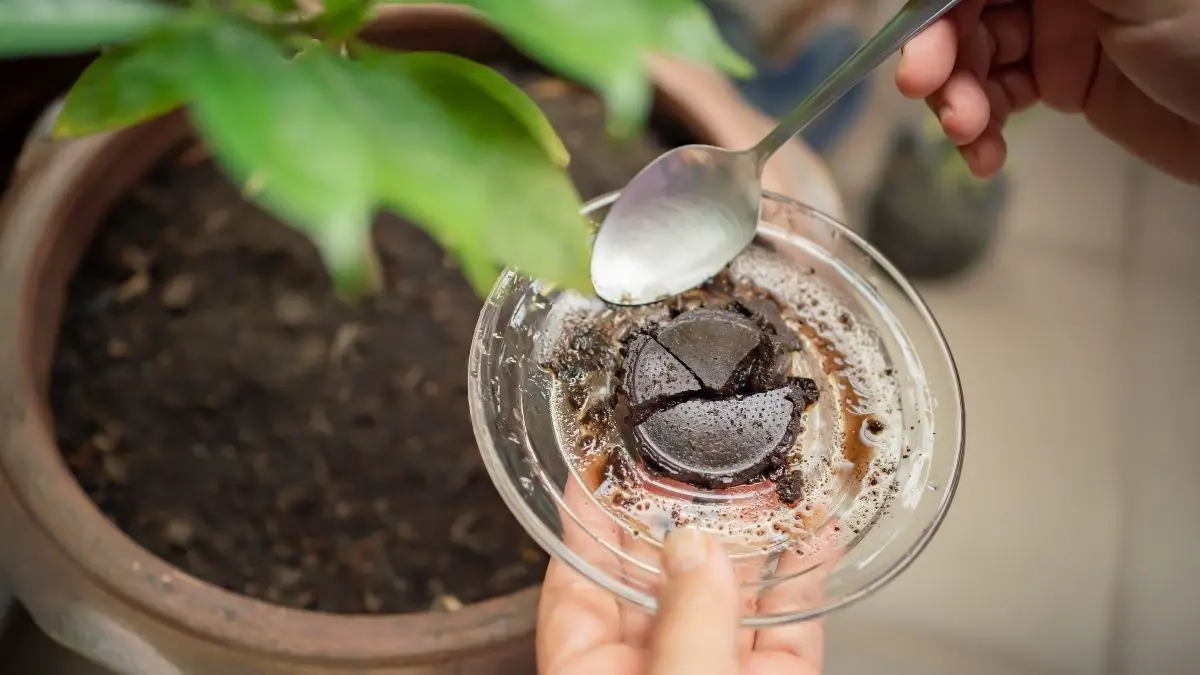If you’re a frequent coffee drinker who likes brewing your coffee at home, then you’re probably faced with the recurring trouble of having to dispose of your used grounds and thought if there’s a way or two of dishing them out more effectively. You may also happen to have a nice bed of green on your property, and since coffee does have rejuvenating benefits for us, you’re tempted to just toss them grounds over your lawn and hope for improvements?
Coffee grounds can and may kill your grass and other plants if used ineffectively or without any prior knowledge of this sort of naturally-derived fertilization. However, coffee grounds are rich in minerals like nitrogen and potassium that do provide benefits to a lawn’s healthy ecosystem, so knowing how to properly apply them can and will help improve your garden.
Caffeine is the worrying factor when it comes to using coffee grounds as fertilizer, this is because caffeine is known to have detrimental effects on other plants. There’s also the issue of earthworm cultivation when it comes to coffee fertilization, but you have to understand how it works first before drawing an incomplete judgment. Finally, once you find yourself being skeptical about using coffee grounds for your lawn, then just avoid it completely because there are a plethora of other creative uses for your used grounds.
Caffeine Uses
Caffeine And Plants
Believe it or not, caffeine, the same stimulant that gives you the kick in a sip of coffee, is also the plant’s natural line of defense and offense. Apparently, besides the fruit, the leaves of a coffee plant also contain traces of caffeine, and when either a fruit or a leaf falls off the branches, they contaminate the ground with this toxin (to plants and some insects at least), disallowing other plants, even their kind, from germinating. This is how coffee plants keep their space to themselves and kill off competition before they can even grow.
As long as the topsoil is infested with caffeine and other acidic components from coffee plants, seedlings can’t hope to prosper. To saplings and smaller plants, the caffeine stimulates their growth and photosynthesis for a while but eventually kills them. If you’d remember, caffeine blocks the adenosine receptors in us, disabling our “rest” hormones and giving us a short boost in physical and mental abilities like adrenaline.
Well, plants don’t have adenosine receptors but they also contain adenosine triphosphate or ATP, and it helps them transfer energy from photosynthesis and aids cell growth. So what caffeine inhibits in plants is their ability to produce cell walls, which when compromised leaves the organisms’ cells vulnerable to harmful factors like diseases, dehydration, and stunted growth. This is a result of caffeine hindering the plant’s ATP functions, similar to us humans. This has less effect on adult and larger plants though and is entirely dependent on the concentration of caffeine in the soil.
Caffeine Against Pests
According to this collection of studies, natural or wild coffee plants are extremely adept at warding off parasites and pests due to their higher concentration of caffeine than their cultivated cousins. This is generally because caffeine is toxic to most insects. After all, they can’t digest it and it only causes nauseating and disabling effects on these critters when they consume the fruits or even the leaves. This makes coffee plants and other caffeine-producing flora like green tea leaves and cocoa, highly resistant to pests.
Caffeine doesn’t affect all bugs though, since bees are able to ingest caffeine when gathering pollen and actually become more effective at it, and while the coffee borer beetle, Hypothenemus hampei, is also the worst biological enemy of Coffea Arabica plants because it digests caffeine very efficiently and nests in their fruits.
With coffee grounds that contain sufficient amounts of caffeine, it may also be helpful to your plants and lawn as a natural insect and pest repellant because these insects recognize the scent and taste of the toxic substance, causing them to flee it. This is less effective though compared to plants that innately harbor caffeine in their systems and are not advised for undeveloped seedlings or saplings.
For Gardening
A good tip is to use spent coffee grounds that are decaf, darker, and courser, as these conditions usually introduce less caffeine. Also, it’s best recommended to let them sit in a compost pile first before direct application to let the acidic components and caffeine decompose significantly, as well as the release of nitrogen and essential nutrients.
Coffee grounds decompose rapidly and conserve nitrogen (~2%) very effectively, creating a highly fertile compost with sufficient heat that indicates healthy microbial propagation and vital organic minerals that aid in plant growth, especially nitrogen which is key to the building blocks and functions of plant cells.
If you’re more of an espresso fanatic and tend to use highly caffeinated grounds, then consider using those against weeds and harmful fungi instead of your garden grass and vegetables. This method is more effective without the pre-compost and can be done with fresh grounds, although I’d rather not waste my fresh grounds on any plant at all.
What I’d recommend is to sprinkle your garden lawn with these grounds first before planting any sort of vegetables or grass as this method would immediately kill and prevent weeds and fungi from growing. Since the effects of caffeinated grounds are short-term, you’d be able to plant your seeds and saplings more effectively afterward such as this study (PDF) suggests but in a wider spectrum of farming.
Earthworms Can Tolerate Coffee Grounds
For a human being, it would take 50-100 cups of coffee in a day to kill them, and a teaspoon of pure caffeine powder is enough to kill you. However, people dying from coffee or caffeine overdose are extremely rare and usually occur due to accidents or stupid self-experimentation. So, if coffee or caffeine overdose can kill a human, why won’t it kill the smallest, wriggly organisms under the earth?
One definite study concluded that the introduction of high doses of coffee grounds or the implication of a coffee-grounds-only diet to earthworms, specifically Eisenia fetida (red worms), in three composting systems: in-vessel, vermicomposting, and aerated static piles, caused significant mortality rates in the worm population. However, with the addition of cardboard materials, the worms were less exposed to the chemical releases of the decomposition of spent coffee grounds, thus mitigating their death tolls.
This simply meant that a balanced diet actually saved the worms than a coffee-only supplication, and just like humans, you’d be better off with a balanced diet than overdose on coffee. So, will coffee grounds kill earthworms and result in the degradation of a garden lawn’s ecosystem? They can if they’re highly caffeinated and the only fertilizers around.
The quick fix to this would be mixing the coffee grounds in a compost first, before introducing them to the earthworm-rich lawn or vermicomposting bin, as this would give a balanced amount of organic minerals and carbon that the worms would benefit from, thus allowing them to thrive for the good of your lawn, or harvesting their castings as pure and natural fertilizers.
If you’d use coffee grounds in a vermicomposting bin, add in more leaves, paper, or cardboard to balance the acidity of the bedding, and watch out for that even more when adding citrus peels as they are also pretty acidic. Worms hate acidic environments and are less likely to survive in such.
Coffee Grounds Are Insignificant Acidifiers
Most of the acids in coffee grounds have already been swept away due to the numerous times they’ve been processed. As cherries, they’re soaked in water and their flesh is peeled off. Then they are dried and crushed. Finally, they’re brewed and extracted, leaving you with spent grounds that are barely acidic with only about 6 to 6.8 pH. Of course, the acidic pH varies from type to type, but that’s pretty much the basics of how coffee grounds are alkalized.
Much of the acids in coffee are water-soluble, especially the fruity ones, which means that once the water is forced through them, they wash away or are extracted by the water and poured onto the drink, which is also why coffee tends to have an “acidic” taste. So what actually receives most of these acidic components is you and the spent coffee grounds themselves are safe to use in soil, but better after composting.
In the end, they won’t acidify your garden soil, at least not significantly, but if you want to make sure that the spent grounds you use won’t be acidic, then once again, go for darker roasts as much of the acidic components are broken down the longer the coffee is roasted.
If you do want to acidify your soil to plant vegetables like tomatoes and celery, then I suggest opt for a real acidic fertilizer or manufactured acidic soil.
Coffee Grounds Are Merciful To Microbes
You may have heard that coffee has natural antibacterial and antioxidant qualities, which do benefit us in a few ways. However, when it comes to gardening, it’s a concern for some that coffee grounds would also kill vital microbes in the soil. According to the Oregon State University, coffee grounds actually provide energy to microbes like a catalyst in compost piles.
Another study affirms that the chemical compounds in coffee do have antibacterial properties, but they’re more concerned and effective against enterobacteria (PDF) which is a family of salmonella, shigella, and E. coli, well-known bacteria that are harmful to humans. There are no studies as of yet that prove coffee grounds kill off compost bacteria, but rather an ample amount of research does suggest that they benefit microbial activities in compost piles.
Compost microbes do not like acidic environments, and fortunately, coffee grounds have high pH and the caffeine which induces acidity also breaks down easily in a compost pile. According to the Washington State University Extension (PDF), a compost pile consisting of less than 20% coffee grounds will create sufficient diversity for a healthy microbial environment. This type of compost pile has been proven to be effective in gardening as an organic fertilizer, but shouldn’t be used in growing seeds as traces of caffeine and other acidic components may still affect early germination.
Bottom Line
You’re more likely to kill your grass if you haven’t done your homework on coffee grounds first. To date, there is more research that supports the abilities of spent and compost coffee grounds to power up your lawn soil, and so it’s highly recommended that you put your spent grounds to good use and help preserve our environment.
However, if you still don’t feel like sprinkling your garden with a bit of coffee ground compost, then you don’t have to feel guilty about throwing them away or using them somewhere else (we’ll soon put up something about this too.)
Coffee grounds can be safely applied to your garden as long as you know how and why, and that’s just as important as going through a tutorial video of anything you’re yet to try. So please, do your garden a favor, do our environment a favor, and do yourself a favor and feel free to use those coffee grounds to boost your gardening.

